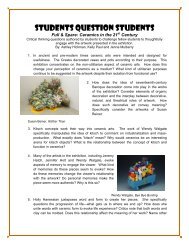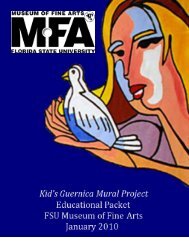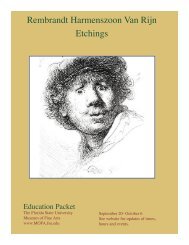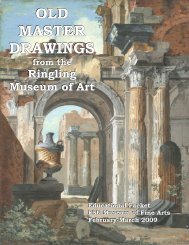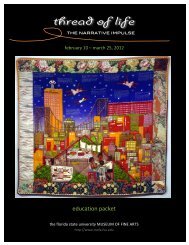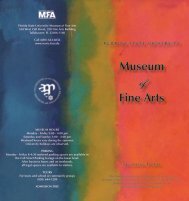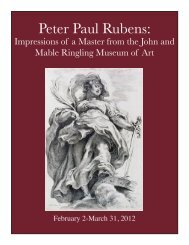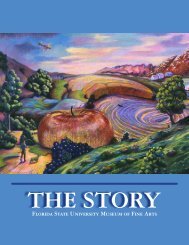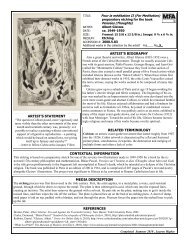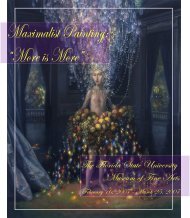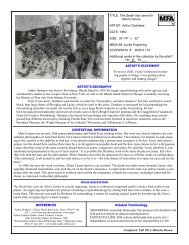Matrix: Contemporary Printmaking - Museum of Fine Arts - Florida ...
Matrix: Contemporary Printmaking - Museum of Fine Arts - Florida ...
Matrix: Contemporary Printmaking - Museum of Fine Arts - Florida ...
Create successful ePaper yourself
Turn your PDF publications into a flip-book with our unique Google optimized e-Paper software.
Fall 2009<br />
Artists’ Biographies<br />
Andy Warhol<br />
Andy Warhol, Self-portrait, 1966,<br />
screen-printing<br />
Andrew Warhol was born in Pittsburgh,<br />
Pennsylvania in 1928. He was the third child <strong>of</strong><br />
working class parents, who were immigrants from<br />
Slovakia. He was raised as a strict Catholic. In<br />
third grade he suffered from the disease called St.<br />
Vitus dance, a complication <strong>of</strong> scarlet fever. This<br />
resulted in long-term effects to his skin coloration<br />
and he became a hypochondriac. He was bedridden<br />
for a lot <strong>of</strong> his childhood. To occupy time in<br />
bed he collected old pictures <strong>of</strong> movie stars and put<br />
them up around his bed. He also drew and listened<br />
to the radio. He says that this period <strong>of</strong> his life was<br />
important to the development <strong>of</strong> his personality.<br />
From a young age he showed talent in art.<br />
When he was old enough he studied commercial art at the School <strong>of</strong> <strong>Fine</strong> <strong>Arts</strong> at<br />
Carnegie Institute <strong>of</strong> Technology in Pittsburgh. In 1949 he moved to New York<br />
City and began a successful career in magazine illustration and advertising. In<br />
1950 he gained fame, something he<br />
always craved, from his shoe ads that<br />
were created by using a loose inkblotting<br />
style. RCA hired him to make<br />
record covers and promotional<br />
material. In 1962 he held his first<br />
exhibit, which included the Marilyn<br />
Diptych, 100 Soup Cans, 100 Coke<br />
Bottles, and 100 Dollar Bills.<br />
During the 60s Andy founded<br />
“the factory,” a studio that became a<br />
hang-out for artists <strong>of</strong> all kinds. Once<br />
Andy started working in the factory he<br />
began to use silk-screening. With his<br />
process he was able to produce his<br />
artwork “en masse.” Warhol liked the<br />
idea <strong>of</strong> silk-screening because he<br />
was making art work using images <strong>of</strong><br />
mass produced products and he was<br />
then mass-producing his art work. He<br />
said that he wanted to be a machine.<br />
Warhol became quickly known for his<br />
brightly colored pop art. Some critics<br />
were turned <strong>of</strong>f by his glorification <strong>of</strong><br />
Andy Warhol, Campbell’s Soup, 1968, silk screen-printing<br />
17



